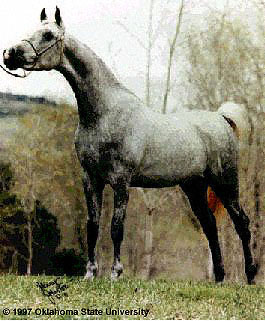

When Europeans sought to improve their saddle horses, Arabians were imported to cross with native strains. The standard procedure was to use purebred Arabians, especially stallions, to improve stock. The Byerly Turk, Darley Arabian and Godolphin Arabian are conspicuous in English Thoroughbred pedigrees. Similar improvement plans took place in France, Germany, Spain, Poland, Hungary, and Russia. Today, Arabians are found throughout the world and the blood of Arabians flows in all breeds of light horses. The Arabian's head has a characteristic dished profile with a prominent eye, large nostrils and small teacup muzzle. His gracefully arched neck rises out of a long sloping shoulder and broad chest. A short, strong back and high trail carriage complete the picture. Arabians come in grey, chestnut, bay and roan and an occasional solid black. Although some individuals will vary, most are between 14.2 and 15.2 hands in height and weigh between 800 and 1,000 pounds.
Ancient Bedouin breeders were careful to record bloodlines and jealously guarded the purity of their Arabians. As a result, even though centuries have passed, today's Arabian cannot be mistaken for any other breed. Whether ridden English or western, shown in park classes or used for trail riding, Arabians have the same basic distinctive appearance.